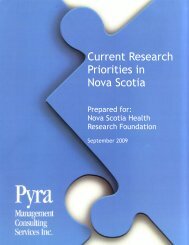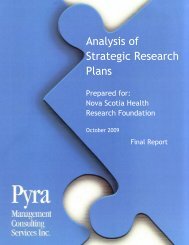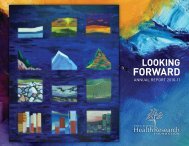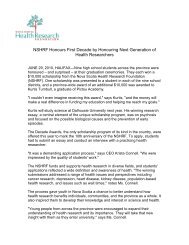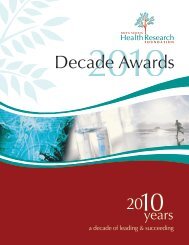Major Health Issues in Nova Scotia: An Environmental Scan
Major Health Issues in Nova Scotia: An Environmental Scan
Major Health Issues in Nova Scotia: An Environmental Scan
Create successful ePaper yourself
Turn your PDF publications into a flip-book with our unique Google optimized e-Paper software.
# Reference Brief Notes<br />
providers and facilities have the will<strong>in</strong>gness and resources available to<br />
properly address the many associated legal and ethical issues.<br />
10. Kearney,AJ. Facilitat<strong>in</strong>g <strong>in</strong>terprofessional<br />
education and practice. Can.Nurse; 2008;<br />
104(3):22-6.<br />
11. K<strong>in</strong>gma,M. Nurses on the move: A global<br />
overview. <strong>Health</strong> Serv.Res.; 2007;<br />
42(3p2):1281.<br />
12. Lavieri,M and Puterman,M. Optimiz<strong>in</strong>g<br />
nurs<strong>in</strong>g human resource plann<strong>in</strong>g <strong>in</strong> british<br />
columbia. <strong>Health</strong> Care Manag.Sci.; 2009;<br />
12(2):119.<br />
13. Normand,C. Strengthen<strong>in</strong>g public health<br />
human resources <strong>in</strong> Europe: Meet<strong>in</strong>g the<br />
tra<strong>in</strong><strong>in</strong>g challenge. Eur.J.Public <strong>Health</strong>; 2004;<br />
14(1):11.<br />
14. Pariyo George,W, Kiwanuka Suzanne,N,<br />
Rutebemberwa,E, et al. Effects of changes <strong>in</strong><br />
the pre-licensure education of health workers<br />
on health-worker supply. Cochrane Database of<br />
Systematic Reviews; 2009; (2): Art. No.:<br />
CD007018. DOI:<br />
10.1002/14651858.CD007018.pub2.<br />
15. Philipp,DL and Wright,DL. Recruit<strong>in</strong>g<br />
healthcare professionals to rural areas.<br />
Radiol.Manage.; 2005; 27(6):44-50.<br />
Collaborative patient-centred care has the potential to address serious<br />
issues <strong>in</strong> the Canadian health-care system such as those related to<br />
<strong>in</strong>creas<strong>in</strong>g complexity of care; patient safety and access; and<br />
recruitment and retention of health human resources. The author<br />
presents the rationale for collaborative care and describes an<br />
<strong>in</strong>terprofessional education project at Memorial University of<br />
Newfoundland that is prepar<strong>in</strong>g students and health professionals for<br />
this groundbreak<strong>in</strong>g change <strong>in</strong> practice.<br />
This paper looks at nurse migration flows <strong>in</strong> the light of national<br />
nurs<strong>in</strong>g workforce imbalances, exam<strong>in</strong>es factors that encourage or<br />
<strong>in</strong>hibit nurse mobility, and explores the potential benefits of circular<br />
migration. The dearth of data on which to develop <strong>in</strong>ternational<br />
health human resource policy rema<strong>in</strong>s. There is grow<strong>in</strong>g recognition,<br />
however, that migration will cont<strong>in</strong>ue and that temporary migration<br />
will be a focus of attention <strong>in</strong> the years to come. Inject<strong>in</strong>g migrant<br />
nurses <strong>in</strong>to dysfunctional health systems--ones that are not capable of<br />
attract<strong>in</strong>g and reta<strong>in</strong><strong>in</strong>g staff domestically--will not solve the nurs<strong>in</strong>g<br />
shortage.<br />
This paper describes a l<strong>in</strong>ear programm<strong>in</strong>g hierarchical plann<strong>in</strong>g<br />
model that determ<strong>in</strong>es the optimal number of nurses to tra<strong>in</strong>,<br />
promote to management and recruit over a 20 year plann<strong>in</strong>g horizon<br />
to achieve specified workforce levels. Age dynamics and attrition<br />
rates of the nurs<strong>in</strong>g workforce are key model components. The<br />
model was developed to help policy makers plan a susta<strong>in</strong>able nurs<strong>in</strong>g<br />
workforce for British Columbia, Canada. <strong>An</strong> easy to use <strong>in</strong>terface and<br />
considerable flexibility makes it ideal for scenario and "What-If?"<br />
analyses.<br />
n/a<br />
The current and projected crisis because of a shortage of health<br />
workers <strong>in</strong> low and middle-<strong>in</strong>come countries (LMICs) requires that<br />
effective strategies for expand<strong>in</strong>g the numbers of health workers are<br />
quickly identified <strong>in</strong> order to <strong>in</strong>form action by policymakers,<br />
educators, and health managers. This study’s objective was to assess<br />
the effect of changes <strong>in</strong> the pre-licensure education of health<br />
professionals on health-worker supply. The authors’ conclude that<br />
the evidence to estimate the likely effects of <strong>in</strong>terventions <strong>in</strong> prelicensure<br />
education to <strong>in</strong>crease health-worker supply is generally<br />
<strong>in</strong>sufficient or unavailable, particularly <strong>in</strong> LMICs. Further research<br />
could focus on determ<strong>in</strong><strong>in</strong>g the magnitude of student drop-out rates<br />
<strong>in</strong> health professional tra<strong>in</strong><strong>in</strong>g <strong>in</strong>stitutions, identify<strong>in</strong>g the students at<br />
risk of dropp<strong>in</strong>g out, and determ<strong>in</strong><strong>in</strong>g the applicability of westernbased<br />
<strong>in</strong>novations <strong>in</strong> low and middle-<strong>in</strong>come countries.<br />
Ma<strong>in</strong>ta<strong>in</strong><strong>in</strong>g an adequate number of healthcare providers for the<br />
nation's most underserved populations is <strong>in</strong>creas<strong>in</strong>gly difficult. Rural<br />
medical services have issues that often complicate recruitment and<br />
retention of qualified medical professionals. This review of literature<br />
exam<strong>in</strong>es some of the issues unique to rural areas. Consideration of<br />
these issues dur<strong>in</strong>g recruitment strategies may lead to <strong>in</strong>creased<br />
recruitment and retention of healthcare professionals to rural areas.



